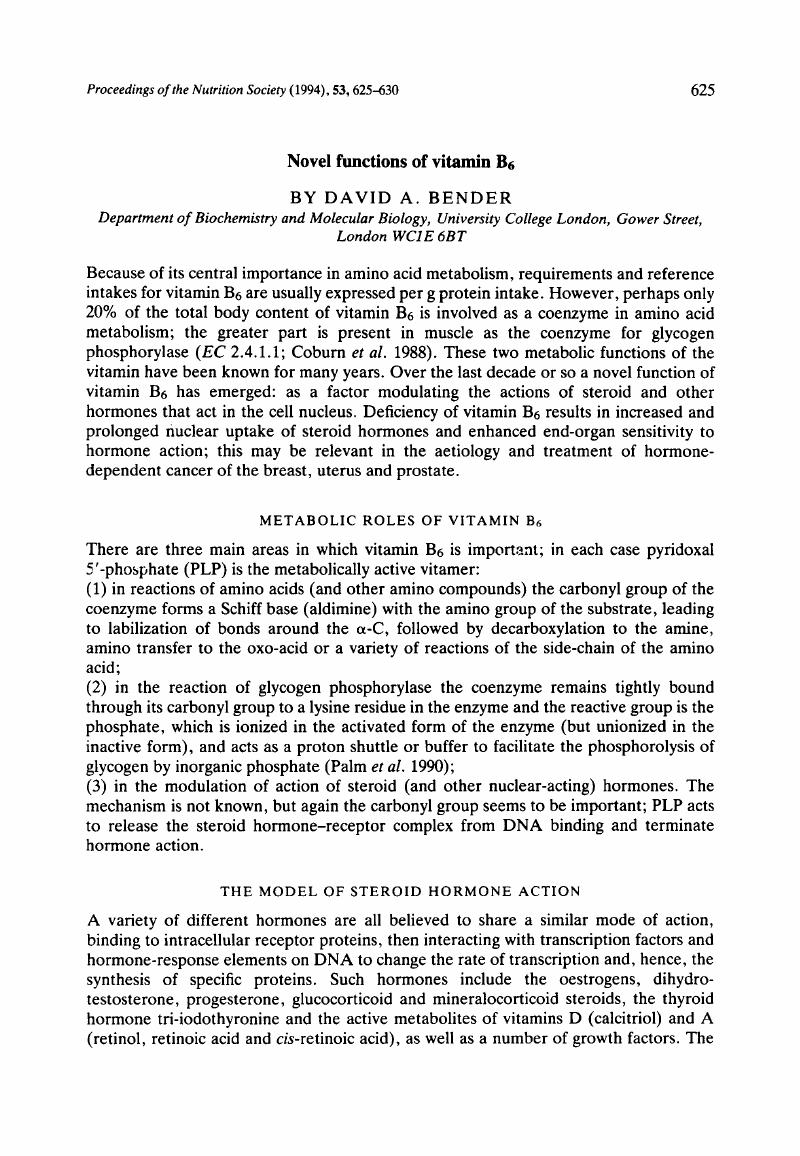Crossref Citations
This article has been cited by the following publications. This list is generated based on data provided by Crossref.
Bender, David A.
1997.
Vitamin B6.
Nutrition & Food Science,
Vol. 97,
Issue. 4,
p.
128.
Cattaneo, M.
Lombardi, R.
Lecchi, A.
Bucciarelli, P.
and
Mannucci, P.M.
2001.
Low Plasma Levels of Vitamin B
6
Are Independently Associated With a Heightened Risk of Deep-Vein Thrombosis
.
Circulation,
Vol. 104,
Issue. 20,
p.
2442.
Oka, T.
2001.
Modulation of gene expression by vitamin B6.
Nutrition Research Reviews,
Vol. 14,
Issue. 02,
p.
257.
Escandar, G.M
Bystol, A.J
and
Campiglia, A.D
2002.
Spectrofluorimetric method for the determination of piroxicam and pyridoxine.
Analytica Chimica Acta,
Vol. 466,
Issue. 2,
p.
275.
Saibeni, Simone
Cattaneo, Marco
Vecchi, Maurizio
Zighetti, Maddalena Loredana
Lecchi, Anna
Lombardi, Rossana
Meucci, Gianmichele
Spina, Luisa
and
Franchis, Roberto
2003.
Low vitamin B6 plasma levels, a risk factor for thrombosis, in inflammatory bowel disease: role of inflammation and correlation with acute phase reactants.
The American Journal of Gastroenterology,
Vol. 98,
Issue. 1,
p.
112.
Stanger, O.
Herrmann, W.
Pietrzik, K.
Fowler, B.
Geisel, J.
Dierkes, J.
and
Weger, M.
2003.
DACH-LIGA Homocystein (German, Austrian and Swiss Homocysteine Society): Consensus Paper on the Rational Clinical Use of Homocysteine, Folic Acid and B-Vitamins in Cardiovascular and Thrombotic Diseases: Guidelines and Recommendations.
Clinical Chemistry and Laboratory Medicine,
Vol. 41,
Issue. 11,
Oshiro, Marilena
Nonoyama, Kimiyo
Oliveira, Raimundo Antônio Gomes
and
Barretto, Orlando Cesar de Oliveira
2005.
Red cell aspartate aminotransferase saturation with oral pyridoxine intake.
Sao Paulo Medical Journal,
Vol. 123,
Issue. 2,
p.
54.
EICHINGER, S.
2006.
Are B vitamins a risk factor for venous thromboembolism? Yes.
Journal of Thrombosis and Haemostasis,
Vol. 4,
Issue. 2,
p.
307.
Weinstein, Stephanie J
Stolzenberg-Solomon, Rachael
Pietinen, Pirjo
Taylor, Philip R
Virtamo, Jarmo
and
Albanes, Demetrius
2006.
Dietary factors of one-carbon metabolism and prostate cancer risk.
The American Journal of Clinical Nutrition,
Vol. 84,
Issue. 4,
p.
929.
Abdollahi, Hamid
Sororaddin, Mohammad Hossein
and
Naseri, Abdolhossein
2006.
Simultaneous Spectrofluorometric Determination of Piroxicam and Pyridoxine Using Generalized Rank Annihilation Method.
Analytical Sciences,
Vol. 22,
Issue. 2,
p.
263.
NISHIJIMA, Saori
SUGAYA, Kimio
HOKAMA, Sanehiro
OSHIRO, Yoshinori
UCHIDA, Atsushi
MOROZUMI, Makoto
and
OGAWA, Yoshihide
2006.
Effect of vitamin B6 deficiency on glyoxylate metabolism in rats with or without glyoxylate overload.
Biomedical Research,
Vol. 27,
Issue. 3,
p.
93.
Morris, Martha Savaria
Picciano, Mary Frances
Jacques, Paul F
and
Selhub, Jacob
2008.
Plasma pyridoxal 5′-phosphate in the US population: the National Health and Nutrition Examination Survey, 2003–2004.
The American Journal of Clinical Nutrition,
Vol. 87,
Issue. 5,
p.
1446.
Rucker, Robert B.
Morris, James
and
Fascetti, Andrea J.
2008.
Clinical Biochemistry of Domestic Animals.
p.
695.
Hazra, Aditi
Kraft, Peter
Lazarus, Ross
Chen, Constance
Chanock, Stephen J.
Jacques, Paul
Selhub, Jacob
and
Hunter, David J.
2009.
Genome-wide significant predictors of metabolites in the one-carbon metabolism pathway.
Human Molecular Genetics,
Vol. 18,
Issue. 23,
p.
4677.
Morris, Martha Savaria
Sakakeeny, Lydia
Jacques, Paul F.
Picciano, Mary Frances
and
Selhub, Jacob
2010.
Vitamin B-6 Intake Is Inversely Related to, and the Requirement Is Affected by, Inflammation Status.
The Journal of Nutrition,
Vol. 140,
Issue. 1,
p.
103.
Kotwal, Jyoti
Kotwal, Atul
Bhalla, Sandeep
Singh, P.K.
and
Nair, Velu
2015.
Effectiveness of homocysteine lowering vitamins in prevention of thrombotic tendency at high altitude area: A randomized field trial.
Thrombosis Research,
Vol. 136,
Issue. 4,
p.
758.
Franco, Carolina N.
Seabrook, Laurence J.
Nguyen, Steven T.
Leonard, Jack T.
and
Albrecht, Lauren V.
2022.
Simplifying the B Complex: How Vitamins B6 and B9 Modulate One Carbon Metabolism in Cancer and Beyond.
Metabolites,
Vol. 12,
Issue. 10,
p.
961.
Surana, Khemchand R.
Ahire, Eknath D.
Patil, Shital J.
Mahajan, Sunil K.
Patil, Dhananjay M.
and
Sonawane, Deepak D.
2023.
Vitamins as Nutraceuticals.
p.
1.
Song, Wen-Xuan
Yu, Zi-Han
Ren, Xiang-Feng
Chen, Ji-Hua
and
Chen, Xin
2023.
Role of micronutrients in inflammatory bowel disease.
World Chinese Journal of Digestology,
Vol. 31,
Issue. 17,
p.
711.
Shukla, Vani
Parvez, Sidrah
Fatima, Ghizal
Singh, Shikha
Magomedova, Aminat
Batiha, Gaber El‐Saber
Alexiou, Athanasios
Papadakis, Marios
Welson, Nermeen N.
and
Hadi, Najah
2024.
Micronutrient interactions: Magnesium and its synergies in maternal–fetal health.
Food Science & Nutrition,
Vol. 12,
Issue. 10,
p.
6913.



